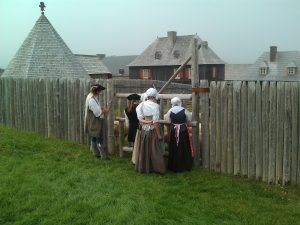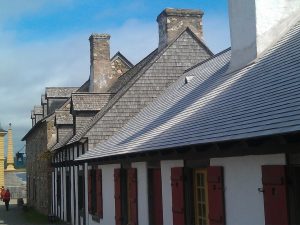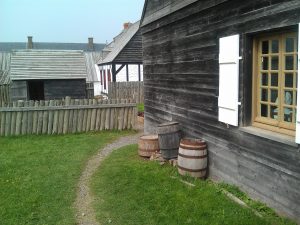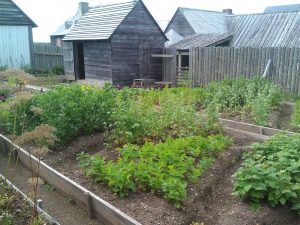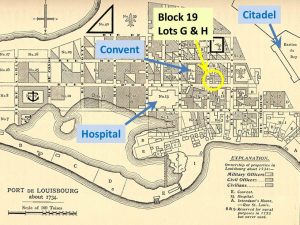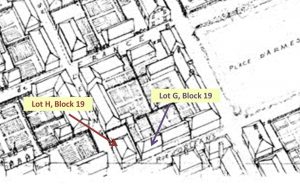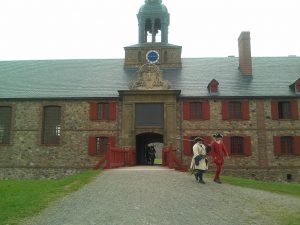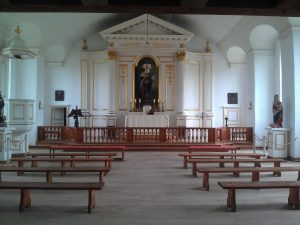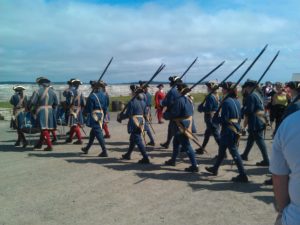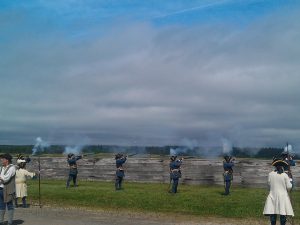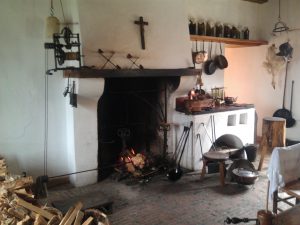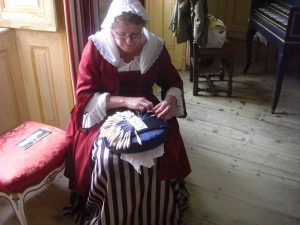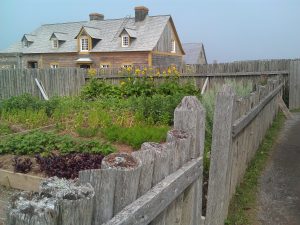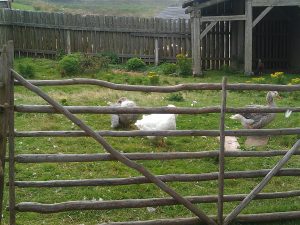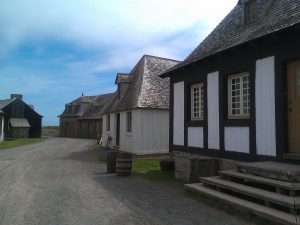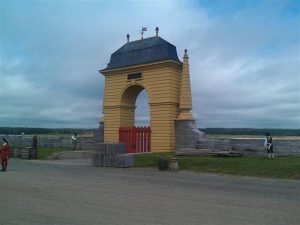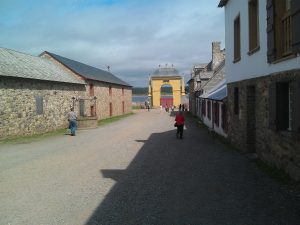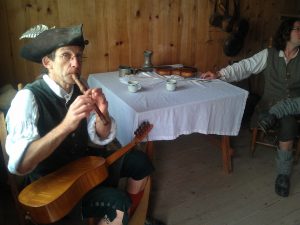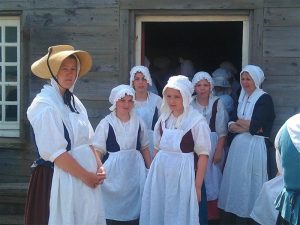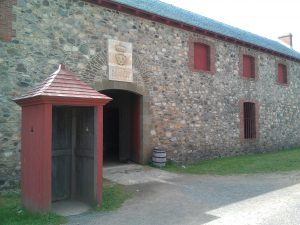(This is the final part of a three-part series about Fortress Louisbourg. The content was published as Appendix 5-A in Chapter 5 of A Violette History, available at Amazon.. Other chapter references here also refer to that same book.)
I took the opportunity during our travels following the Violette Family Reunion 2011 to visit the Louisbourg area to learn more about where my ancestors had lived. I wanted to walk the streets and get the feel for the place where Charles, Marie David, and François had lived during the period 1749-1758. My visit was during late August so the place was open for visits and there were a moderate number of visitors during my visits. The National Park also has a few dozen people dressed in period costumes that engage in programmed activities to illustrate aspects of life in Louisbourg in 1745. The portrayed time frame is just before the British and New Englanders laid siege to Louisbourg in 1745, as described in this chapter, and at the peak of a long phase of French development of the port and city that had started around 1713. The French community in Louisbourg was well developed and to society and community there had had many years to mature.
The reconstruction of the fortified town of Louisbourg by the government of Canada was started in 1961 and has resulted in approximately 25% of the town being rebuilt. The buildings are authentic and even have original materials used where they could be found. But all reconstruction has been faithful to the methods and materials of construction in use at the time.
Our ancestors arrived in Louisbourg in 1749, however, after the siege of 1745 resulted in the British taking over Louisbourg and subsequently letting go of it three years later. So the Louisbourg we see today in reconstruction shows what it would have looked like prior to the siege and bombardments in 1745 and prior to any changes made by the British during their occupation of 1745-48. Remember that the reason Charles went to Louisbourg was to work on reconstruction of Louisbourg when the French took it back.
So the Louisbourg we see today is different from what Charles and François saw when they lived there and we have no idea what “their” Louisbourg looked like. However, we can suppose that the French did not change their styles of construction during this period and they probably resurrected the layout of the town following the scheme they had used during 1719-1745.
François was five years old when he came to Louisbourg and was fourteen when his father returned to France; he was assigned to (and probably moved in with) a surrogate guardian when he was seven. During my visits to Louisbourg I tried to look at Louisbourg from two different points of view: as it might have been for a child of those ages, and as an adult of today trying to understand the history.
Part of trying to see Louisbourg through those eyes required trying to determine where Charles and Francois lived, to see if it was in one of the structures that have been reconstructed. We have no specific address or property description to help us in this search, but there is some information that might be helpful. Maurice Violette found records that in 1753 Charles contracts for a house on Rue D’Orleans (see Chapter 7 and Chapter 8) about one block away from the Citadel (see Chapter 8). Charles apparently wanted not only a residence but also a place to have a boutique. Maurice also describes Charles’ house to be near the hospital and the Convent of Notre Dame.
The lease contract does not give the location of the property but does give the name of the owner, Allain Le Gras. After some searching I was able to find that M. Le Gras owned some property on Lots G and H in Block 19, on Rue D’Orleans. The map below (Map A-1) shows where that property was located and indicates where the hospital and convent were. The map was taken from the document published by Yvon Leblanc, former restoration architect for the Louisbourg restoration project. See http://fortress.uccb.ns.ca/yvonleblanc/ for more information.
The description contained in the contract language included in Maurice’s text (see Chapter 8) seems to describe an arrangement of buildings that agrees with what is portrayed in Figure A-1 at right; this figure was taken from the research documents prepared by Yvon Leblanc to determine what had been in Louisbourg and how it should be restored. Figure A-2 shows an enlargement of the Block 19 area.
Unfortunately, the current reconstruction did not include Block 19; as can be seen in Figure A-1 reconstruction fell a block and a half short (see blue line). The site of the hospital and convent are marked in the field, but none of the other buildings on Rue D’Orleans outside the reconstruction area are identified.
But the Block 19 residence came after Charles’s bankruptcy in 1751, and we do not know where Charles and his family lived prior to that. We can assume that it was further away from the center of town, however, since the homes nearer the center were occupied by military officers, merchants, and governmental officials.
After Charles’s bankruptcy François and Alexis were sent to live with their surrogate parents so they would not have lived in the Block 19 residence.
We know from the court proceedings reported by Maurice Violette (see Chapter 7) that François became the ward of Jacques Bognais de la Boissiere and Alexis the ward of Pierre Jauvin. (Both surrogates’ names are spelled differently in different sections of the Petition and Judgment, so we are not exactly sure how to spell them.) We have tried to track down more info about Bognais and where his family might have lived, but without success so far. We think it likely that Bognais was a military officer but have not yet found any record of him in that capacity. We have found some baptismal records for two Bognais children that show military officers or people related to the military being godparents for the Bognais children, and that is a basis for suggesting that Bognais was military himself.
In trying to see Louisbourg through François’ eyes I have tried to imagine what he might have been doing during those years. He was young – seven years old – when he was assigned to the Bognais family so prior to that he probably did not have much in the way of duties. Assuming Charles’s family lived in the outskirts of the town François probably spent most of his time in the area around their residence. It is not likely that he wandered the 8-12 blocks from where he lived into the center of town. We also do not know where the Bognais family lived, though we have tried to find references for this. Since Bognais had his family in Louisbourg he must have been an officer and as an officer he must have had a French title. His name as given in the records seems to indicate this: the “de la Boissiere” part tells us the reference for his title but we have not yet found more details about that holding. But as an officer he most likely lived closer into town, such as in the general area where Block 19 was located.
We also don’t know how and when François left Louisbourg. It is likely that Bognais, if he survived the bombardment of 1758, returned to France with the military after Louisbourg was lost to the British. Did François leave with the Bognais family? He would have been fourteen at that time and not likely to have been emancipated. Then too, we do not know where the Bognais family went to when they left.
So, Francois might have been with the Bognais family from around age seven to age fourteen. We don’t know what life as a surrogate child was like; were they treated as children of the family or were they treated more like servants who had to work to repay the debt of their natural parents?
In any case, as I walked the streets of Louisbourg I could imagine François running along the street, perhaps on an errand to pick up an item or two at a store, or bakery, or tavern. When I stood in the former Engineer’s back yard and saw the gardens there I could imagine François working at tending the vegetables growing there. When I saw the goats in the pen at the residence near the King’s Bastion I could imagine François perhaps feeding the animals that would provide milk and cheese for his family. When I walked along the quay I could imagine François standing on the street watching in amazement and wonder at all the activity in the harbor filled with ships as load after load came ashore with materials to support the Louisbourg community.
The photos below as well as those above show scenes in the reconstructed Louisbourg and were taken during my visit in August 2011. The period portrayed in Reconstructed Louisbourg is 1745; though this is just before the siege and capture by the British and New Englanders in 1748 Louisbourg as reconstructed by the French starting in 1749 probably looked very similar to what is portrayed here. In selecting the photos to show here I tried to find images of scenes that François might have seen in his time.


